#Indian Ocean Region
Video
youtube
China's Game in the Indian Ocean Region IOR Using Maldives as a Bet
0 notes
Text
Indian Ocean Regional Tourism Integration

Indian Ocean Tourism Organization is a non-profit organization established to unite regional tourism integration among 30+ Member States and Island Nations within the Indian Ocean.
0 notes
Link
India’s absence from the meeting of 19 nations of the Indian Ocean region, hosted by China this week, is conspicuous.
0 notes
Text

Ei Sun OH is immensely grateful for the #faith & #trust of the #Commonwealth #Magistrates & #Judges #Association members in re-electing him as #CMJA Council Member.
L to R: Datuk Stephen Sondoh JP, Datuk Seri Panglima Clarence Bongkus Malakun JP, Dr Karen Brewer (CMJA Sec-Gen), Oh, Judge Bernard Georges (Seychelles) posed after the #IndianOcean 🌏 #regional meeting.
0 notes
Text
This is a big deal. No, $48,692.05 is in no way, shape or form a fair price for the many thousands of acres of traditional Chinook land that were never ceded but were taken by settlers anyway. However, the fact that this funding from the 1970 Indian Claims Commission settlement is being released to the tribe is the strongest move toward regaining recognition in years.
As a bit of background, the Chinook Indian Nation are some of the descendants of many indigenous communities who have lived in the Columbia-Pacific region and along the Columbia to the modern-day Dalles since time immemorial. They saw the arrival of the Lewis & Clark party to the Pacific Ocean in 1805, but shortly thereafter were devastated by waves of diseases like malaria and smallpox. The survivors signed a treaty to give up most of their land in 1851, but it was never ratified by the United States government. While some Chinookan people are currently part of federally recognized tribes such as the Yakama Nation, the Confederated Tribes of the Warm Springs Reservation, and the Confederated Tribes of the Grand Ronde Reservation, the Chinook Indian Nation--comprised of the Lower Chinook, Clatsop, Cathlamet, Willapa, and Wahkiakum--have remained largely unrecognized.
That changed briefly in 2001. On January 3 of that year, the Department of the Interior under the Clinton administration formally recognized the Chinook Indian Nation. In July 2002, the Bush administration revoked the federal recognition after complaints from the Quinault Indian Nation, as the Chinook would have had access to certain areas of what is now the Quinault reservation. This meant that the Chinook, once again, were denied funding and other resources given to federally recognized tribes, to include crucial healthcare funding during the COVID-19 pandemic.
The Chinook Indian Nation has been fighting legal battles to regain federal recognition ever since the revocation. The funding released to them in this month's court decision doesn't make them federally recognized, but it is a show of legitimacy in a tangled, opaque system that indigenous people across the United States have had to contend with for many decades. Here's hoping this is a crack in the wall keeping the Chinook from recognition, and that they get more good news soon.
#Chinook Indian Nation#Chinook#Chinookan people#indigenous people#indigenous Americans#indigenous rights#landback#federal recognition#Bureau of Indian Affairs#Native American#Native American rights#civil rights#United States
323 notes
·
View notes
Text
Notes on a South Asian Tropical Cyrodiil (and more!)
So, many TES fans know that before Oblivion, Cyrodiil was supposed to be tropical. The most striking phrase to describe it, "most is endelss jungle", says it all. The quick and snarky explanation is that Todd Howard watched LOTR, was "inspired" by it, and that's why everything in Oblivion looks sort of like a Rennaisance Fair. In any case, I think it was a huge missed opportunity, especially in a world where most popular fantasy is European inspired, to have replaced what could have been very cool tropical enviroments with what is frankly a lame "Talos used his magic" lore retcon. You can read the 1st edition of the Pocket Guide to the Empire to see what we missed.
But it's not only Cyrodiil which we missed this way… Tamriel just makes more sense as a tropical continent. While the size and the exact location of the continent is discussed by nerdier nerds than me, I think it does make sense like this, and not only that, we have a very interesting world parallel to compare it to: India. From a tropical rainy south to the cold mountains of Skyrim, Tamriel is surprisingly similar to the Indian subcontinent, and many of its geographical quirks can be explained if, instead of assuming a temperate Cyrodiil, we go all out with that concept. This is going to be a long post, you have been warned.
So with that in mind, I'll try to make a not-so brief tour (with some evocative pictures along the way) of a rebuilt tropical Tamriel, following the rains of the moonson:
The position of Tamriel, in this case, would be roughly where the Indian subcontinent is located in real life, that is again, tropical, stretching the Tropic of Cancer (is there a name for the tropics of Nirn? Interesting to think about) Here, we see our numbers pan out well: Tamriel is mentioned to be between 4000 and 3000km across east to west and 2000 and 3000km south to north. VERY, VERY roughly, there is 4000km between Pakistan and Myanmar, and 3000km from Sri Lanka to the northern tip of Tibet. Plot that on a map, and you already can see some coincidences. Now, this is a rather average continent, not Pangea sized like some imagine Tamriel to be. This does help explain why, for example, the interior of Cyrodiil is rainy and good for agriculture instead of a desert. But it also means that it's very likely that Tamriel is ruled by monsoons. Monsoons are complex, but they basically form when there are plenty of warm places for water to evaporate (the South Indian ocean), and mountains that block cool winds from the opposite direction (the Himalayas). We have a very similar situation here, with a mountainous Skyrim on the north of a tropical Cyrodiil facing an equatorial southern ocean. So, what happens are monsoons, perhaps not as strong as IRL India, but carrying rains very deep into the continent. This would feed the rivers and the rich agricultural areas of Cyrodiil, and would have some other consequences.
So let's imagine our trip South to North. In the South, in Black Marsh, Blackwood and Lleyawiin, and Pellentine (southern Elsweyr) we would find, much like in the original lore, humid tropical climates, jungle, wetlands, and my favorite, mangrooves. I would expect mangrooves to stretch in this whole area, across rivers. In fact, one of the reasons why Black Marsh could be so hard to explore and control by the Empires at Cyrodiil would be the presence of thick mangrooves all over its coast. This is the region of Cyrodiil that would most resemble "endless jungle".
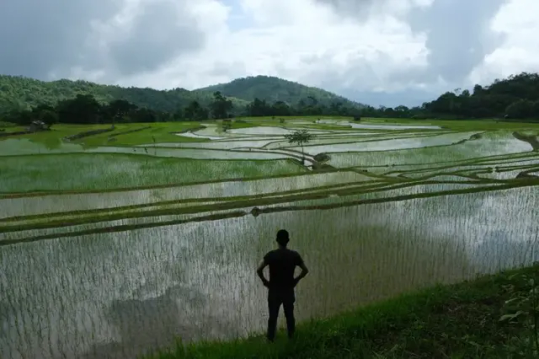
(Rice fields in India, what I imagine most of this Tropical Cyrodiil would look like)
However, as any lore person knows, Anequina, northern Elsweyr, is arid desert. Does this mean a contradiction? Far from it, we have a similar example in IRL India: the Deccan Plateau, which has a semi-arid to arid climate. This can be easily explained by higher elevations up to a small mountain chain separating it from Cyrodiil to the north, and the fact that little rain would reach behind this "Anequina Plateau" would make the region of Kvatch and Anvil more dry much like in canon, in this case, more scrublike. This highland desert would not be as harsh as Elsweyr is usually concieved, maybe, but its driest regions might justify places such as Dune. (On that matter, it always bothered me to read about the "cities" of southern Elsweyr and there being only two or three there. If I had to redesign it, I would move some from the north to the south).

(the Deccan Plateau in India, it gets greener or drier according to the monsoon)
Keeping on our tour of Tamriel, the Topal Bay and the very rainy Black Marsh funnels the rainy monsoon from the south towards central Cyrodiil. Here we find the endless jungle of the Nibenay Valley. But unlike the rainforests of Elsweyr and Black Marsh, these dense forests and rich river plains are mediated by the monsoon winds, with dry seasons alternating with copious rain. This has huge effects on agriculture and culture in general, as agriculture is defined by the rythms of the rain. Keeping with our South Asian theme and the 1st edition of the Guide to the Empire, Cyrodiil would have huge extensions of rice paddies, as well as terrace farming and much hardier crops in the highlands, instead of the… well, almost absent agriculture we saw in Oblivion. The food, clothing, architecture and overall culture of Cyrodiil would be very different with this. The original Pocket Guide said some of its main exports besides rice and fruit are moon sugar and silk. Moon sugar in Cyrodiil, can you believe it?
Another thing I imagine Cyrodiil would be famous for would be fish and seafood, well, river food. Rice plantations can host fishes and crustaceans to get some extra protein, and well, what about mudcrabs? Hell, as preparing muddy soil is vital for rice cultivation, no wonder mudcrabs are considered a nuisance. Imagining critters in gameplay in such an enviroment also makes my mind roam. Tigers, elephants, rhinoceros, and this is not even getting into the more mythical creatures you could find, instead of endless wolves… Rice cultivation is also more labor intensive than other crops, and it also has a deep impact on the terrain, "terraforming" so to say, huge expanses into paddies and terrace farms. This level of cultivation also requires an established infraestructure of irrigation. While this does not necessarily means a centralized goverment, as farmers can build it and maintain it by themselves, the rise of an empire, i.e., the Empire, will also increase the complexity of these systems, adding canals, dams, reservoirs and more ambitious projects, like we see in India and China. I am sure some people more knowledgeable about those cultures can comment more.
While this Cyrodiil is a tropical/subtropical region covered in "endless jungle", some parts might indeed resemble the rolling hills and grasslands you see in Oblivion. Deforesting jungle for pasture is something very common around the world (some have joked this mass deforestation was later in canon explained as a gift from Talos lol) and you can see the results, like in tropical Australia and my closer Mata Atlantica, do superficially resemble temperate pastures in say, Europe. Until you notice the palm trees, of course. But yes, I can see the Nords being a mostly herding people (more on that below) bringing their sheep and cows to the tropical lowlands and, well, deforesting to make space for them.
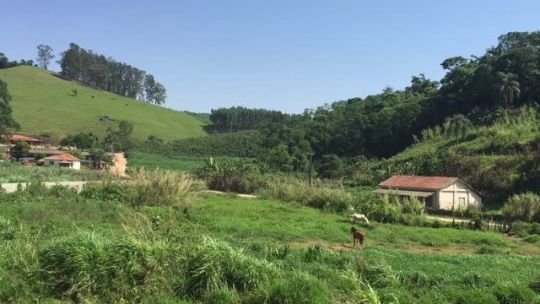
(ranches in Sao Paulo state, Brazil, notice the palm trees)
Imperial City just so happens to be built in an island in the middle of several river crossings, in what seems to be a swampland. The first thing that came to mind when I read that was Tenochtitlán. The districts of Imperial City would have been built over the centuries on artificial islands on a shallow lake, using plentiful mud and organic matter to make fertile chinampas. I believe this would make for a striking sight. Instead of just a city in the middle of a empty island, you would see the White-Gold tower and the rest of Imperial City rising from Lake Rumare, surrounded by rich farmland and its districts joined by walkways. (much like the old descriptions, actually, could you believe I wrote that without reading them?)

(Reconstruction of Tenochtitlán... and I just noticed, it's surrounded by (volcanic) mountains too, much like Imperial City)
Much like the Pantanal is one of the sources to the Paraguay River (which merges with the Paraná and then the Río de la Plata) IRL, here, the swamps of central Cyrodiil would be the source of the Niben. This does raise an interesting question, where is the source of the Niben? Is it Lake Rumare? No, I believe it would be several smaller rivers all the way from Bruma and even Skyrim. These small, violent mountain rivers eventually flow into the Rumare wetlands and only THEN in the placid great Niben. You DON'T want to be caught in one of the mountain valleys in rainy season. This does raise the question; won't the developments upriver, like Imperial City itself and the surrounding farmland, affect the course of the river downwards? There's plenty of water from the rain, but a more developed Cyrodiil might indeed have to grapple with this, supposing, for example, they manage to dam the river.
Looking west, we got the Colovian region, said to be composed of drier highlands and cliffs in the early Pocket Guide. Probably cut from the rain because of the Anequina Plateau, this is indeed more arid or "mediterranean", though I actually see it as more Australian. Maybe some of the drier parts near Hammerfell, resembling Argentine Cuyo and the northwest, would be a distant cry from the wetlands, having thorny dry forests and dry valleys, where yes, you could plant wine. The wetter cloud forests (much like the Yungas in South America, the place where the rain reaches last) could maybe be the home of the last pre-Imperial cultures of Cyrodiil. Fascinating places.

(Jujuy, Argentina. Just *near* are the Yungas cloud forests, where the last rains from the Atlantic meet the Andes, making for some AMAZING places)
Given that I mentioned enviroments near to/on the Andes IRL, let's talk about potatoes. Potatoes are unique crops, because they are the only ones who offer such calories and also be planted in cold enviroments like Europe. Or Skyrim. The discovery and spread of potatoes would cause demographic shifts on people living in cold areas. And they also originated in a unique enivorment IRL: the Andes, actually with possible hybridization from the Magallenic foresWHAT I MEAN, is that potatoes are very important and have been domesticated in very specific conditions. The Wroghtgarian Mountains would seem like a perfect equivalent of the Andes at the first glance, but they would be very different. The Andes, located between the Pacific Ocean and the greater Amazonian region, are very, very unique enviroments. These mountains, however, are in between inner seas. Something like the Atlas or the Alps? In any case, if there is some people who would appreciate hardy tubers that can grow in mountainous places, they are for sure the Orcs, or perhaps the Reachmen. Maybe an hybridization even between them?
This returns me back to Bruma and Skyrim. Some people (who make those excellent Oblivion mods) imagine Bruma with a Tibetan flavor. Personally, I imagine it more like Pakistan or Afghanistan, with lots of mesas and plateaus and valleys. It would look dry and rocky with some very fertile valleys by snowmelt, but it would look like a snowy wonderland on winter, indeed, Pakistan and Afghanistan are very snowy. Eventually, of course, ending up in the great barrier of the Jerall mountains and finally, Skyrim.

(the Alps? Skyrim? No, this is Kashmir on winter!)
In this scenario, Skyrim would be a quite dry place… or would it? There is no need for the Jeralls to be a straight line of peaks like the Himalayas. They could be a more "broken" series of mountains, like the southern Andes, but in any case, the rain from the south would clash into the higher mountains. Indeed, that is what actually happens in the Himalayas, the foothills of the Himalayas are some of the rainest places IN THE WORLD. These small valleys are something very unique and not very well known part of the world IRL. I can imagine the Skyrim equivalent would be as unique too, hard to navigate and live in. The forests of the Rift and Falkreath would be mazes of windy forests valleys, each with their own unique secrets under a perpetual fog and drizzle. This is a very interesting enviroment to imagine, where again, some of the older cultures of Tamriel could still live.
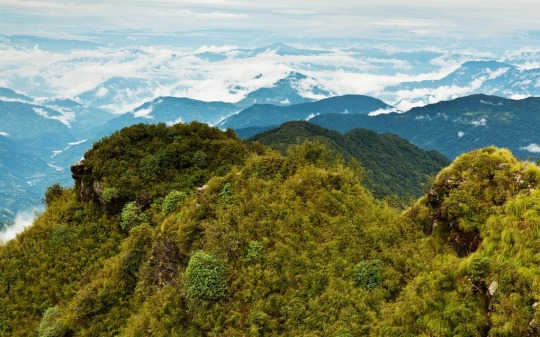
(forests of Bhutan, note how the humid valleys stretch into the distance before the cold Himalayas begin)
However, what does Skyrim look like once you cross the border with Ralof? I imagine some sort of more fertile Tibet, not as high as the Tibetan plateau, allowing for forest and alpine tundra. This is mostly because, while Skyrim is high up, I don't imagine as a plateau, but rather a series of broken mountains like the North American Rockies, which makes sense when you account for all the volcanic activity (there is another super-volcano down in Skyrim but nobody notices). I imagine that Skyrim would be a primarily herding pastoral land before the introduction of hardier crops such as potatoes, and even then. Nord culture would be very interesting reimagined like this; hillforts guarding herds of sheep and cows. It would also create a clash between the very, very agrarian south and the nomadic herding north, with High Rock and Hammerfell a gradient between the two.
I decide I will stop here, I haven't even touched Valenwood (though its subtropical forest seems rather coherent to me), High Rock (the most boring part of Tamriel IMO), Hammerfell, Summerset Islands (if you don't have tropical elves in your setting, you're a coward), or whatever the hell is going on Morrowind. But I hope you enjoyed this worldbuilding exercise and how to make sense of Tamriel's crazy geography. Next time, I'll try to play with tectonics and see if we can make it even more interesting.
But here we enter a problem; if we are operating on a level where Cyrodiil is roughly at the same latitude of India, wouldn't that make Skyrim too far from the poles to allow its tundra like climate, even with elevation? No doubt. Tibet is only as cold as it is because it's the roof of the world and far from any ocean. The northernmost tip Skyrim, like Tibet, would be at the latitude of Turkey, Korea or California, which can get quite cold, but not to the level of what we see on Winterhold or Dawnstar (Solitude sounds familiar, though). What's more, having an ocean up north would only moderate the temperature. Cool currents often don't bring cold per-se, just decrease rainfall. This would end with a very temperate and pleasant Skyrim instead of tundra. Which is on its own, interesting to explore.
Could Nirn be going through an ice age, like it's implied with the dissapearance of Atmora? Possibly, but it would imply revising everything I said before, as ice ages decrease rainfall and mess up with weather patterns all over the world. A colder Nirn would explain a lot, though.
If you liked what you read and would like more worldbuilding, consider tipping me on Ko-Fi and send me stuff to talk about, or just send an ask! I'm the kind of guy who reads encyclopedias and RPG manuals for fun, so I have plenty to talk about about everything from fantasy to science fiction to speculative evolution and alternate history!
#worldbuilding#tes#elder scrolls#skyrim#oblivion#the 'do more tropical worldbuilding you eurocentric cowards' agenda#fantasy#cosas mias
239 notes
·
View notes
Text
Wed Beast Wednesday: Mudskippers
For this Wet Beast Wednesday I want to go over a fish that seems to have forgotten it's a fish: the mudskipper. Mudskippers are amphibious fish that are just as comfortable on land as they are in the water. Mudskippers are classified as gobies but goby taxonomy turns out to be weirdly complicated and there's not a clear consensus of what clade constitutes a goby. Mudskippers are members of the subfamily Oxudercinae and consist of at least 23 species, with some sources list up to 43 species. Not all members of Oxurdercinae are considered mudskippers, only those who live a partially terrestrial lifestyle. Mudskippers live in tropical to temperate regions throughout the Pacific, Indian and Atlantic oceans.

(image id: a mudskipper sitting on a branch just above the surface of the water. It is a long, skinny fish with a large head and two large eyes positioned on the top of its head. Its pectoral fins are large and its dorsal fins are folded up. The tail fin is submerged and not easily visible. It is mostly light brown, but has a black stripe going down the body and small, blue speckles all over.)
Mudskippers have a fairly standard goby body plan, but with adaptations to support their terrestrial lifestyles. The most important adaptations for a fish that wants to live on land is to develop an ability to oxygenate themselves without continuously passing water over the gills. Mudskippers have developed two ways to breathe out of water. The first is with their gills. The gill pouch can be sealed off, trapping a bubble of water inside, keeping their gills continuously in contact with water. The gill filaments are also stiffer than in most fish and do not coalesce with each other if they dry out. In addition, the skin, mouth, and throat can absorb oxygen with the help of many small blood vessels, but must be wet to do so. Mudskippers spend up to 3/4th of their time on land, but will die if they dry out. They live mostly in the intertidal zone, primarily on mangrove forests and mud flats, where they have access to water but also plenty of room to move and hunt on land. To assist in moving on land, the pectoral fins have evolved into pseudo-feet. The fins of most ray-finned fish are simple, consisting of a group of inflexible fin rays attached to the body that can be moved (individually in some species) by muscles in the body. Mudskippers have their fin rays jointed part way through and again at the connection to the body. This creates a "shoulder" and "elbow" joint in the fins, giving them greater strength and flexibility. Mudskippers can drag themselves along with their pectoral fins in a skipping motion, which is the source of their common name. Some species can use their pectoral fins to climb on mangrove roots or other exposed plants and rocks. Mudskippers are also adept jumpers. By rapidly folding and extending their tails, mudskippers can leap up to 61 cm (24 in). This is used primarily to escape predators and for display purposes, but may also be used to leap onto higher vantage points. Mudskipper eyes are also special. They are located very high on the head and protrude quite a bit from the body. This eye position gives the mudskipper a very wide range of vision and allows them to bury themselves in mud, only leaving the eyes exposed. Mudskippers can also blink, something other fish cannot do. To blink, a mudskipper will retract an eye into its body while a membrane called a dermal cup rises to cover the eye. Blinking allows the mudskipper to clean its eyes and keep them moist on land. Mudskippers are small fish, with the largest species (Periophthalmodon schlosseri, the giant mudskipper) getting to about 28 cm (11 in) long.
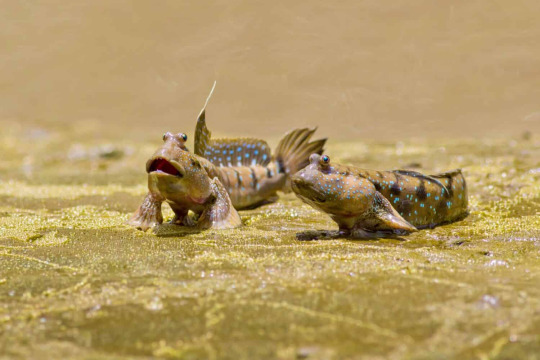
(image id: two mudskippers sitting on sand. one has its front end eld up by its pectoral fins and its mouth partially open. This one's dorsal fins are extended, which run down the body. The other one is lying flat had has its both closed and its dorsal fins folded down. They are light brown with dark stripes. The dorsal fin has many blue dots)
Mudskippers build burrows using their fins and mouths. These burrows are used for shelter and for mating. Most burrows will have their oepning exposed during low tide but will flood during high tide. A chamber in the burrow holds a pocket of air even when flooded. This allows the mudskipper to breathe even if the water is low in oxygen, though it must periodically bring in mouthfuls of air to refresh the pocket. During mating season, males will build burrows. after the burrow is completed, he will come out and start competing for mates. Competitions involve jumping, with the make who can jump the highest attracting the most females. Sometimes mudskipper will fight over territory, though males are especially prone to fighting during mating season. Fights consist of the fish demonstrating at each other with open mouths and raised dorsal fins. During fights, they will also vocalize at each other, with the one who can string together the most vocalizations being the winner. How mudskippers vocalize is still a mystery. Most fish who make sound do so with their swim bladders, but mudskippers don't have swim bladders. Once a female picks a male to mate with they will return to his burrow, where she lays eggs and he fertilizes them. The female departs afterwards, leaving the male to care for the eggs. He will guard the burrow against predators and bring air in to keep the eggs oxygenated until they hatch.

(image id: a mudskipper mid-jump. Its fins are all extended and its body is covered in blue spots)
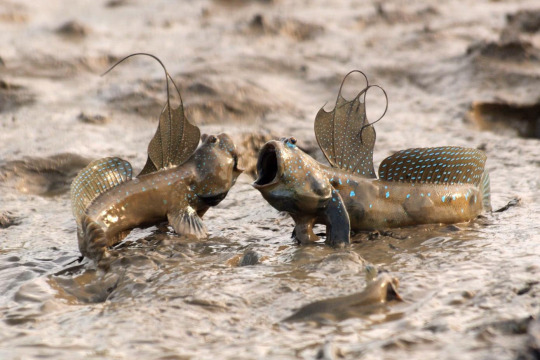
(image id: two mudskippers fighting. They are facing each other with mouths open, heads pointing up, and fins fully extended)
The majority of mudskipper species are carnivores, though some have transitioned to being detritivores. They hunt invertebrates including worms, insects, and crabs, and some species are cannibalistic. They can hunt both on land and in water, but are more effective at land hunting. When in water, mudskippers use the same suction feeding method that most predatory fish use. When on land, mudskippers use a different method. They carry water in their mouths and chase after prey. When positioned over their prey, the mudskipper will spit some of the water out, allowing it to cover the other animal. It then sucks the water back in, carrying the prey with it. The suction also help propel the prey to the throat, which is useful because mudskippers lack tongues to push their food back.

(image id: a mudskipper in its burrow.The entrance to the burrow is raised above the ground and made of sand. Only the mudskipper's head is visible)
Mudskippers are useful to science in a few ways. They are useful as bio-indicator for the health of their environments. Breathing through your skin is a double-edged sword. It lets you oxygenate on land, but also makes it easier for harmful chemicals to enter the body. Dissection of certain organs allows for testing of environmental chemical levels. Passive observation can also provide data on environmental health. Mudskippers are also used as a model organism for scientists studying the transition of vertebrates to land. While the fish that colonized land were lobe-finned fish as opposed to the ray-finned mudskippers, they can still provide clues to the adaptations and lifestyle of the earliest tetrapods. Outside of science, mudskippers are used for food and as pets. The different species had different classifications by the IUCN ranging from least concern to critically endangered. Their main threats are pollution, habitat loss, and overfishing.

(image id: two mudskipper facing the camera with their mouths open)
#wet beast wednesday#fish#fishblr#fishposting#mudskipper#marine biology#biology#zoology#ecology#animal facts#fish that forgot how to fish
285 notes
·
View notes
Text
Sayyed Abdulmalik al-Houthi, leader of Yemen’s Ansar Allah, said on Thursday, March 14, that his country’s armed forces will expand their attacks against ships moving to Israel from the Red Sea region to the whole of the Indian Ocean.
Stating that attacks on Israeli ships in the Red Sea and Bab el-Mandeb will continue until there is a ceasefire in Gaza, al-Houthi declared that “we [now] aim to prevent ships associated with the Israeli enemy from crossing [Indian] Ocean towards South Africa and the Cape of the Good Hope” as well.
#Yemen#imperialism#shipping#Indian Ocean#Israel#FreePalestine#GazaGenocide#Ceasefire#Ansar Allah#Struggle La Lucha
135 notes
·
View notes
Text
Gharial rescued from sea
Another instance of more recent croc news, a "giant" gharial was found in the Indian Ocean off the coast of Balsore, eastern India.
According to news articles, the animal, an adult Indian Gharial (Gavialis gangeticus), meassured around 13 feet or in metric close to 4 meters in length while weighing some 118 kilos.

The gharial apparently got caught in a fishing net and was found by fishermen, who promptly reported their catch to the Forest Department. The department then handed the animal over to Nandankanan Zoological Park, where the crocodilian still resides.
That's all the information given to us by the article, which you can read here, but there's two key notes I wanna touch upon.
The first is size. At 4 meters, this gharial was decently large for sure and as someone who has seen a (stuffed) female of slightly greater proportions I can attest that it must have been an impressive animal. However, I think its worth mentioning that Indian gharials are capable of growing even larger. The female I just mentioned is accompanied by a stuffed male nearly 5 and a half meters in length, with some reports claiming sizes even greater than that.
Me and the Vienna gharials

The second point is the mysterious presence of a gharial this far out at sea. This is simultaneously unusual yet also very much reasonable from the point of view of paleontology.
On the one hand, Indian gharials are critically endangered. Their range today is incrediply spotty and isolated and to my knowledge they aren't found anywhere near the coast these days.
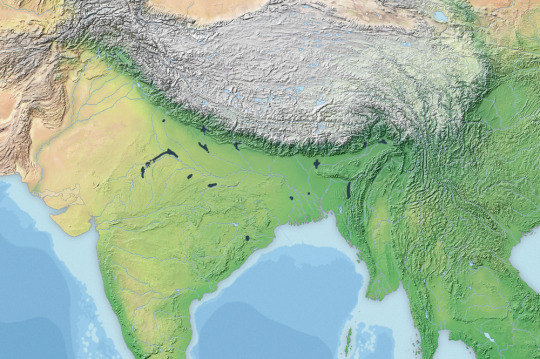

However when you look at how the range was meant to be like, then you see that they definitely reached the river deltas and coastal regions. So our image of gharials as this inland freshwater species is more based in circumstance than reality.
This becomes especially apparent once you begin to consider the paleobiogeography of gharials. Based on our current knowledge, gharials most likely originated somewhere in Eurasia or Africa, spreading from there across much of the eastern hemisphere and beyond (full disclosure I am not considering thoracosaurs to be gavialoids, more on that can of worms later maybe). Anywho, phylogenetic analysis and the fossil record both suggest that gharials then crossed oceans and settled South America sometime prior to or during the Miocene, where they diversified and gave rise to the gryposuchines. Some species even remained saltwater species, such as Piscogavialis, which lived in the coastal waters of Peru.
Although gryposuchines were once thought to be a distinct subfamily of gharial, recent research suggests that they were but an evolutionary stepping stone, with some South American form once again crossing the Pacific and settling down in Asia where the much more basal "tomistomines" or false gharials (a misnomer) still resided. And while the gryposuchines of South America went extinct, those that returned to Asia survived and eventually gave rise to the Indian Gharial of today.
Left: A cladogram showing the relationship between Gryposuchinae and modern gharials
Right: Piscogavialis swimming overhead some marine sloths of the genus Thalassocnus by @knuppitalism-with-ue


So ultimately, seeing a gharial in saltwater is much less bizarre than one would initially think, its just that habitat destruction and overhunting have largely pushed these gorgeous reptiles further inland and to the brink of extinction.
#gharial#indian gharial#gavialis gangeticus#gavialidae#news#croc#crocodilia#crocodile#india#herpetology#gavialinae#gryposuchinae#piscogavialis#some paleontology#palaeoblr
241 notes
·
View notes
Text
this african history & archaeology before colonialism class is opening my eyes so much to aspects of the continents history that i was ignorant about and i'm really falling in love with africanist historiography in general it is so refreshingly materialist and at least in my experience so far there is no beating around the bush or excuses made on the topic of european colonialism, introduction of capitalism, slavery in its many forms across the continents history, the ways in which antiblackness has been gendered throughout history, etc. and for me in particular as an asian there is something about studying the indian ocean trade region in which africans and asians have been in near-constant contact for thousands of years with very little european involvement until later years, an entire maritime world in which we migrated and traded and married and warred and talked between regions as distant as east africa and china for sooooo long and with such complexity and it all had almost nothing to do with europeans. knowing there were bantu speaking africans in ancient china commanding armies and chinese and indian traders as far as madagascar sharing meals with local merchants and learning each other's languages. there was still violence of course - antiblackness even during these times existed, albeit in a different manifestation from the last 500 years of european racism, not to mention misogyny and class violence - but there is something about knowing an entire "world" existed that was shared between our peoples and generally speaking on a much more even 'playing ground' in which all parties must be mutually negotiated with, and coexistence between us... the rich stories and lives lived, and the lessons that entire region can tell us if we only pay attention...
150 notes
·
View notes
Text
The East India Company ships
The East and West India Company ships were not ship types in the usual sense. They were generic terms for a series of merchant ship types that travelled between Europe and the overseas colonies in the East and West. Common features of these ships were three masts, several cannons and a high bulwark to make it more difficult for attackers to board them. Their valuable cargo made the ships attractive targets, so they often travelled in convoys, accompanied by medium-armed merchant ships or frigates for protection. But let's go into more detail.

The East Indiaman 'Earl of Abergavenny', off Southsea, by Thomas Luny 1801
The ships of the East India Company were the ships of the English East India Company, a public limited company (shipowners at the early time of the East India Company contributed their ships to the company and received a certain share in the company in return. They received a proportionate share of the company's overall profits and received a dividend even if their own ship was lost, since the 18th century the company build their own ones as well.) which traded with Asia from 1600 to 1834. The company had a monopoly on trade with the East Indies, China and other regions, and its ships carried goods such as spices, tea, silk, cotton, porcelain and opium. The company also played an important role in the colonisation and administration of India and other territories.

East India Company ships at Deptford, by English School, c. 1660
The ships of the East India Company were known as East Indiamen or as Indiamen and were among the largest and most modern of their time. They were designed to withstand long voyages, carry heavy cargoes and defend themselves against pirates and enemy ships. They were also equipped with cannons and muskets and had a crew of sailors, soldiers, officers and passengers. Because of the need to carry heavy cannons, the hull of the East Indiamen - like most warships of the time - was much wider at the waterline than on the upper deck, so the guns on the upper deck were closer to the centreline to increase stability. This is known as a tumblehome. The ships usually had two complete decks for accommodation within the hull and a raised aft deck. The aft deck and the deck below were lit by galleries with square windows at the stern. To support the weight of the galleries, the hull lines were full towards the stern. As mentioned above, the ships were armed and painted to look like a warship and an attacker could not be sure if the embrasures were real or just painted, and some Indiamen carried a substantial armament.
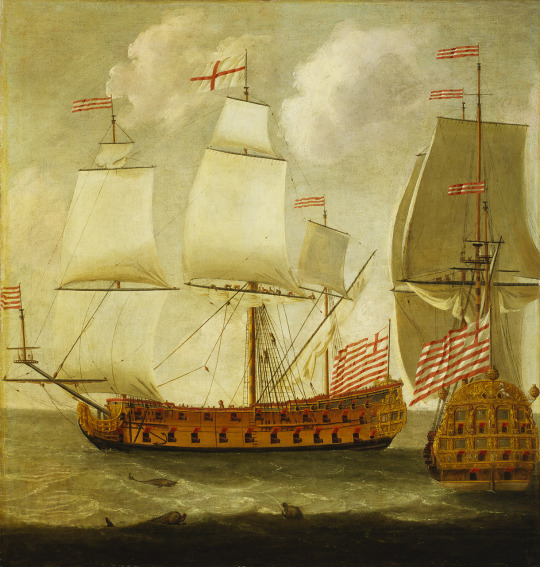
Two views of an East Indiaman of the time of King William III, by Issac Sailmaker, 1685
The Royal Navy acquired several East Indiamen during the Napoleonic Wars and made them fourth rate ships (e.g. HMS Weymouth and HMS Madras), perpetuating the confusion of military ships with merchant vessels as prizes. In some cases, the East Indiamen successfully fended off attacks by the French. One of the most famous incidents occurred in 1804 when a fleet of East India ships and other merchant vessels under Commodore Nathaniel Dance successfully fought off a squadron commanded by Admiral Linois at the Battle of Pulo Aura in the Indian Ocean. And during this time, some of the ships were even travelling under the protection of a Letter of Marque, which allowed them to make their own prizes.

The East Indiaman 'Prince of Wales' disembarking troops off Gravesend, 1845, by John Lynn, 1845 or later - She was built by Green's of Blackwall in 1842 to a design known as that of the "Blackwall Frigates" - Indiamen with the single-decked appearance of frigates.
The ships of the India Companies were not only involved in trade, but also in exploration, diplomacy, warfare and scientific research. They visited many harbours and islands, built factories and forts, fought in battles and wars, negotiated treaties and alliances and collected samples and data. With the advent of the smaller and faster Blackwall Frigates in 1834 came the end of the great Indiamen as these small frigates sailed much faster.
#naval history#east and west india company#ships#1600-1834#blackwall frigate#age of sail#merchant vessels
94 notes
·
View notes
Text
The Achaemenid/First Persian Empire is kind of wild. At the time of its greatest conquests it was the largest empire the world had ever seen, by a significant amount. Like any good empire it's a triumph of logistics, of course, but what's unusual is the character of the logistics in question. The kinds of empire we're used to are generally either basically maritime (Roman, Spanish, British, American) or basically horselord (Xiongnu, Parthian, Mongol, American) or Chinese (special case, the general tendency for there to exist a Chinese Empire is impressive in its own right but relatively familiar).
The Achaemenid Empire touched a lot of seas and bodies of water (Indus, Indian Ocean, Persian Gulf, Tigris and Euphrates, Red Sea, Nile, Mediterranean, Aegean and Bosporus, Black Sea, Caspian Sea) and certainly these would have been used to facilitate logistics to some degree (Persian invasions of Greece relied on naval support, for example), but it certainly seems like the fundamental lifeline of their state was their extensive system of roads. The Romans talk a big game about their road system but ultimately the major logistical corridors of the Roman state were maritime and riverine. The Inca Empire was similarly road-based, likewise a hilly/mountainous region, and is also extremely cool, but didn't last nearly as long and was much smaller.
Herodotus says: "There is nothing mortal that is faster than the system that the Persians have devised for sending messages. Apparently, they have horses and men posted at intervals along the route, the same number in total as the overall length in days of the journey, with a fresh horse and rider for every day of travel. Whatever the conditions—it may be snowing, raining, blazing hot, or dark—they never fail to complete their assigned journey in the fastest possible time. The first man passes his instructions on to the second, the second to the third, and so on." A different translation of a section of this passage is famously associated with the US postal service.
Herodotus may be wrong in the details because the actual intervals between adjacent waystations seem to have been on the order of 16-26km, a distance a rider could reach in an hour (and perhaps most relevantly, a pedestrian or army might reach in a day), and as such it's certainly plausible horses were changed more than daily, as is attested in later relay postal networks, but it's easily possible he was right about their incredible speed. A perhaps somewhat generous estimated speed of government messages along this route is ~230km/day, by analogy of the pirradazish to the Pony Express and barid systems. This would make them faster than Roman communications, though certainly we have to recognize that maritime transport is ultimately faster and more convenient for trade in bulk goods and food. All figures taken from H.P. Colburn, "Connectivity and Communication in the Achaemenid Empire" Journal of the Economic and Social History of the Orient 56 (2013).
That's so cool! It's several hundred BCE and they have a complex permanent relay system with stations every couple dozen km, on a system of roads running throughout an empire thousands of km from center to edge. Just for one road, like the Sardis-Susa section that the Greeks usually talk about, that's over a hundred stations, each with a stock of supplies, backup mounts and riders, accommodations, anything else they might need, and Sardis-Susa was just one possible road stretch among many. That's incredible! I wish we knew what the people who made it and ran it thought. What was the life of a gas station attendant waystation operator in the reign of Artaxerxes I like?
It's kind of tragic that the Achaemenid Empire has been marginalized historiographically for so long. Generally it was treated as significant for its invasions and meddling in Greece, for ending the Babylonian captivity, or for providing a ready-made empire for Alexander to take over. It's not nothing, other places and time periods end up with much less of an imprint on our contemporary understanding of the past. We know a lot of cool stuff. But I wish we had more reflections on Persia from within. Most of what we seem to have is reports from Greeks, fragmentary letters and steles, and precious few excavation sites.
168 notes
·
View notes
Text
Indian Ocean Regional Tourism Integration

Indian Ocean Tourism Organization is a non-profit organization established to unite regional tourism integration among 30+ Member States and Island Nations within the Indian Ocean.
#Indian Ocean Regional Tourism Integration#Indian Ocean Tourism Organization#Indian Ocean Tourism#Tourism Indian Ocean
0 notes
Text
Daily Ray Fact:
I will never get over how PRETTY this species is!! It's a personal favorite 🫶
The Spotted Eagle Ray is found globally in tropical regions, including the Atlantic, Pacific, and Indian Oceans. Spotted eagle rays are most commonly seen alone, but occasionally swim in groups, and are hunted by a wide variety of sharks.

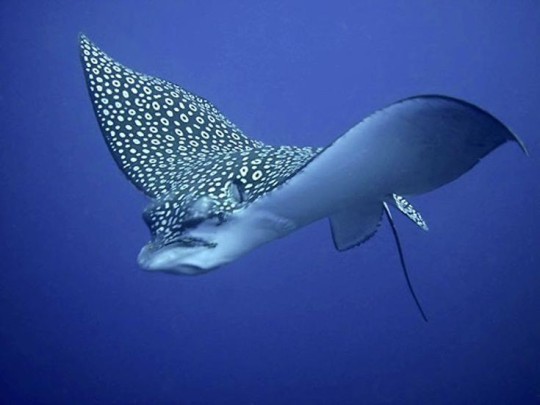
#spotted eagle ray#eagle ray#gorgeous#so pretty#pretty ray#respect the locals#cartilaginous fish#daily ray facts#facts about rays#ray facts#fish#spotted ray
100 notes
·
View notes
Note
Books you would recommend on this topic? Colonial, post colonial, and Cold War Asia are topics that really interest me. (Essentially all of the 1900s)
Hello! An entire century is huge and I don't quite know what exactly you're looking for, but here we are, with a few books I like. I've tried organising them, but so many of these things bleed into each other so it's a bit of a jumble
Cold War
1971 by Srinath Raghavan: about the Bangladesh Liberation War within the context of the Cold War, US-Soviet rivalry, and the US-China axis in South Asia
Cold War in South Asia by Paul McGarr: largely focuses on India and Pakistan, and how the Cold War aggravated this rivalry; also how the existing tension added to the Cold War; also the transition from British dominance to US-Soviet contest
Kennedy, Johnson, and the Nonaligned World by Robert B. Rakove: on the US' ties with the Nonaligned countries during decolonisation and in the early years of the Cold War; how US policy dealt with containment, other strategic choices etc
South Asia's Cold War by Rajesh Basrur: specifically about nuclear buildup, armament and the Indo-Pak rivalry within the larger context of the Cold War, arms race, and disarmament movements
Colonialism
India's War by Srinath Raghavan: about India's involvement in World War II and generally what the war meant for South Asia politically, economically and in terms of defense strategies
The Coolie's Great War by Radhika Singha: about coolie labour (non-combatant forces) in the first World War that was transported from India to battlefronts in Europe, Asia and Africa
Unruly Waters by Sunil Amrith: an environmental history of South Asia through British colonial attempts of organising the flow of rivers and the region's coastlines
Underground Revolutionaries by Tim Harper: about revolutionary freedom fighters in Asia and how they met, encountered and borrowed from each other
Imperial Connections by Thomas R. Metcalf: about how the British Empire in the Indian Ocean was mapped out and governed from the Indian peninsula
Decolonisation/Postcolonial Asia
Army and Nation by Steven Wilkinson: a comparative look at civilian-army relations in post-Independence India and Pakistan; it tries to excavate why Pakistan went the way it did with an overwhelmingly powerful Army and a coup-prone democracy while India didn't, even though they inherited basically the same military structure
Muslim Zion by Faisal Devji: a history of the idea of Pakistan and its bearing on the nation-building project in the country
The South Asian Century by Joya Chatterji: it's a huge book on 20th century South Asia; looks at how the subcontinental landmass became three/four separate countries, and what means for history and culture and the people on the landmass
India Against Itself by Sanjib Baruah: about insurgency and statebuilding in Assam and the erstwhile NEFA in India's Northeast. Also see his In the Name of the Nation.
I hope this helps!
36 notes
·
View notes
Text
Van Helsing's misinformation
I took a look at some of the claims Van Helsing makes in his "immortal parrots" speech on the 26th of September.
Why was it that Methuselah lived nine hundred years, and 'Old Parr' one hundred and sixty-nine...
The oldest authenticated age that anyone has ever reached is 122 years (Jeanne Louise Calment, 1875-1997). Thomas Parr ('Old Parr') allegedly lived from 1483 to 1635 (which is 152 years, not 169) but the 1895 Dictionary of National Biography, which has an entry for Parr, is very sceptical about his claim, noting that his exact age was "attested by village gossip alone."
Here's Old Parr, painted by an unknown artist:

Do you know the altogether of comparative anatomy and can say wherefore the qualities of brutes are in some men, and not in others?
Comparative anatomy is a perfectly reasonable field, but coupled with "the qualities of brutes" and it being the 1890s, I strongly suspect this is some racist physiognomy bullshit (see p550 here for an example of how this looked in contemporary writing, if you must).
Can you tell me why, when other spiders die small and soon, that one great spider lived for centuries in the tower of the old Spanish church and grew and grew, till, on descending, he could drink the oil of all the church lamps?
This one is delightfully weird. It seems to be a telephone-game version of this story, printed in a variety of magazines and miscellanies (e.g.) since 1821:
The sexton of the church of St Eustace, at Paris, amazed to find frequently a particular lamp extinct early, and yet the oil consumed oil, sat up several nights to perceive the cause. At length he discovered that a spider of surprising size came down the cord to drink the oil. A still more extraordinary instance of the same kind occurred during the year 1751, in the Cathedral of Milan. A vast spider was observed there, which fed on the oil of the lamps... It weighed four pounds, and was sent to the Emperor of Austria, and is now in the Imperial Museum at Vienna.
Here's a photo of St Eustache:
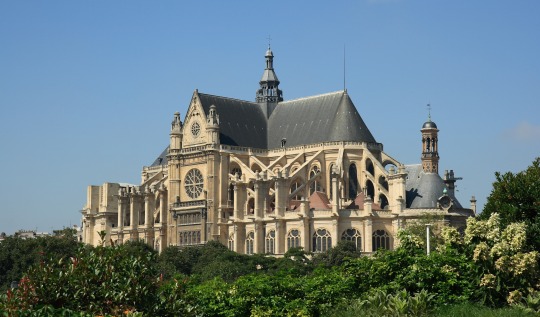
In 1894 the story was reprinted in Notes and Queries, with the question: "Are the statements therein pure fiction? If not, can any one tell me how much we may safely believe? A spider weighing four pounds [1.8kg] is indeed a heavy tax on the reader's credulity."
In reality, the largest spider in the world is the Goliath birdeater, which weighs 175g.
Can you tell me why in the Pampas, ay and elsewhere, there are bats that come at night and open the veins of cattle and horses and suck dry their veins...
Vampire bats are real, and live in parts of South and Central America. The prey of the common vampire bat can include cattle (source). The quantity of blood that they drink is small - in the region of 100g, or about a fifth of a typical blood donation. Vampire bat predation can result in the death of much larger animals, but from infection, not draining them dry.
Here's a common vampire bat:

... how in some islands of the Western seas there are bats which hang on the trees all day, and those who have seen describe as like giant nuts or pods, and that when the sailors sleep on the deck, because that it is hot, flit down on them, and then—and then in the morning are found dead men, white as even Miss Lucy was?
From Wikipedia:
West Sea or Western Sea may refer to:
Atlantic Ocean
Pacific Ocean
Indian Ocean
Mediterranean Sea...
So that's not the most helpful starting point. I don't know which bats these are supposed to be, though hanging in trees like giant nuts makes them sound like fruit bats. In Van Helsing's defence, bats do carry a lot of viruses.
Can you tell me why the tortoise lives more long than generations of men...
Lovely to reach something that's just straight-up true. The current oldest living land animal is Jonathan, a 190+-year-old Seychelles giant tortoise.

... why the elephant goes on and on till he have seen dynasties...
Asian elephants live to be 50 or so; African elephants, 60-70 years. Weirdly, it seems to have been widely believed in the 1890s that elephants lived for a century; e.g. that's cited as fact in the 1894 Encyclopaedia Britannica. Either way, "dynasties" feels like an exaggeration.
... why the parrot never die only of bite of cat or dog or other complaint?
I've tried but I can't find where Bram Stoker got this one from. Maybe he made it up. The English Illustrated Magazine, 1897, contains an article complaining about how easily grey parrots die after being imported and sold as pets.
Can you tell me why men believe in all ages and places that there are some few who live on always if they be permit; that there are men and women who cannot die?
I've also got no idea what's going on with this one. I can't figure out how to look into it without coming up with lots of 1890s Christian literature on the immortal soul, which is not what Van Helsing is getting at.
We all know—because science has vouched for the fact—that there have been toads shut up in rocks for thousands of years, shut in one so small hole that only hold him since the youth of the world.
This was a wildly popular myth in Victorian times (see this article for more details). An article in The Gentleman's Magazine, 1877, entitled 'Some Facts and Fictions of Zoology' (reprinted in several other places) went into the question in more detail, and concluded:
These tales are, in short, as devoid of actual foundation as are the modern beliefs in the venomous properties of the toad, or the ancient beliefs in the occult and mystic powers of various parts of its frame when used in incantations.
Here's a toad:

Can you tell me how the Indian fakir can make himself to die and have been buried, and his grave sealed and corn sowed on it, and the corn reaped and be cut and sown and reaped and cut again, and then men come and take away the unbroken seal and that there lie the Indian fakir, not dead, but that rise up and walk amongst them as before?
This seems to have been widely believed in the late 19th century - e.g. this 1897 book references "two undoubted cases... one of whom had remained alive under the ground for six weeks, the other for ten days". This 1880 magazine says that it "will appear incredible" but relays the story of a fakir "buried alive for forty days, then disentombed and resuscitated" as fact.
The longest verified case of someone surviving without drinking water is Andreas Mihavecz, an 18-year-old bricklayer who was mistakenly locked up by police for 18 days. Even then, he drank condensed water from the walls, and was very close to death when he was found.
So in summary:
Old Parr: false
Physiognomy: false
Enormous oil-drinking spider: false
Vampire bats: partially true
Bats killing sailors: partially true
Long-lived tortoises: TRUE
Long-lived elephants: false
Immortal parrots: false
Belief in immortality: ???
Imprisoned toads: false
Buried fakirs: false
I guess there are some disadvantages to having an "absolutely open mind."
104 notes
·
View notes